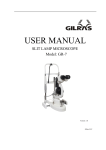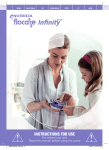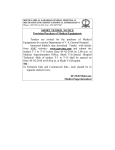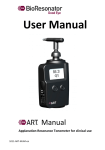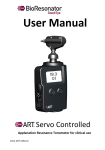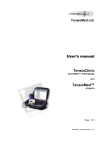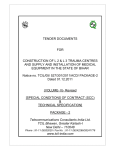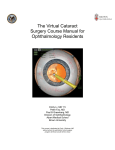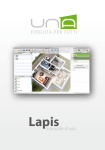Download 1-Auto Refractometer
Transcript
1-Auto Refractometer astigmatism An automated refractor, or autorefractor, is a computer-controlled machine used during an eye examination to provide an objective measurement of a person's refractive error and prescription for glasses or contact lenses. This is achieved by measuring how light is changed as it enters a person's eye. The automated refraction technique is quick, simple and painless. The patient takes a seat and places their chin on a rest. One eye at a time, they look into the machine at a picture inside. The picture moves in and out of focus and the machine takes readings to determine when the image is on the retina. Several readings are taken which the machine averages to form a prescription. No feedback is required from the patient during this process. Within seconds an approximate measurement of a person's prescription can be made by the machine and printed out. In some offices this is used to provide the starting point for the optometrist in subjective refraction tests. Here, lenses are switched in and out of a phoropter and the patient is asked "which looks better" while looking at a chart. This feedback refines the prescription to one which provides the patient with the best vision. Automated refraction is particularly useful when dealing with non-communicative people such as young children or those with disabilities. for any device it has serial number & markka & model 2-Lensmeter ● ● ● ● ● ● ● ● ● ● ● ● Automatic measurement and data storag e Automatic measurement for progressive lenses Measurement of UV-permeabilit y Measurement of pupilary distanc e Contact lens mod e Backlit color touch scree n Extended measuring range -80 to +80 diopto r Calculation of resulting pris m Ergonomic design and operatio n Feature selection via touch screen, to enable nergonomic operatio Touch Screen with adjustable contras t 3-slit lam p The slit lamp is an instrument consisting of a high-intensity light source that can be focused to shine a thin sheet of light into the eye. It is used in conjunction with abiomicroscope. The lamp facilitates an examination of the anterior segment, or frontal structures and posterior segment, of the human eye, which includes the eyelid, sclera,conjunctiva, iris, natural crystalline lens, and cornea. The binocular slit-lamp examination provides stereoscopic magnified view of the eye structures in detail, enabling anatomical diagnoses to be made for a variety of eye conditions. While a patient is seated in the examination chair, he rests his chin and forehead on a support to steady the head. Using the biomicroscope, the ophthalmologist oroptometrist then proceeds to examine the patient's eye. A fine strip of paper, stained with fluorescein, a fluorescent dye, may be touched to the side of the eye; this stains the tear film on the surface of the eye to aid examination. The dye is naturally rinsed out of the eye by tears. A subsequent test may involve placing drops in the eye in order to dilate the pupils. The drops take about 15 to 20 minutes to work, after which the examination is repeated, allowing the back of the eye to be examined. Patients will experience some light sensitivity for a few hours after this exam, and the dilating drops may also cause increased pressure in the eye, leading to nausea and pain. Patients who experience serious symptoms are advised to seek medical attention immediately. Adults need no special preparation for the test; however children may need some preparation, depending on age, previous experiences, and level of trust. The slit lamp exam may detect many diseases of the eye, including: ● Cataract ● Conjunctivitis ● Corneal injury such as corneal ulcer or corneal swelling ● Diabetic retinopathy ● Fuchs' dystrophy ● Keratoconus (Fleischer ring) ● Macular degeneration ● Presbyopia ● Retinal detachment ● Retinal vessel occlusion ● Retinitis pigmentosa ● Sjögren's syndrome ● Uveitis ● Wilson's disease (Kayser-Fleischer ring) 5-projector 5-air puff An air puff type tonometer having a source for projecting a light beam toward the cornea of an eye to be tested, an alignment sensor for receiving the light beam after reflection from the cornea and providing a corresponding received light signal, a device for detecting optical alignment based on the received light signal, a device for directing an air puff, a device for providing an applanation signal corresponding to the applanation state of the cornea when the cornea is applanated by an air puff upon the cornea, an A/D converter for converting the applanation signal in accordance with a preset comparison reference value, and a device for setting the comparison reference value based on quantity of light received by the alignment sensor. Puff tonometry or "non-contact" tonometry is definitely still used, especially in optometric practices. It is a good screening test but can sometimes overestimate pressures. Not as accurate as goldman tonometry but very sensitive in picking up pressure problems. Glaucoma, however takes much more than pressure to diagnose and up to 30% of people with glaucoma can have normal pressures. By the way the test will not hurt the eye and glaucoma can occur at any age but much more common as you get older. 1-audiometer An audiometer is a machine used for evaluating hearing loss. The invention of this machine is generally credited to Dr. Harvey Fletcher ofBrigham Young University. Audiometers are standard equipment at ENT clinics and in audiology centers. They usually consist of an embedded hardware unit connected to a pair of headphones and a feedback button, sometimes controlled by a standard PC. Audiometer requirements and the test procedure are specified in IEC 60645, ISO 8253, and ANSI S3.6 standards. Audiometer were originally invented byAlexander Graham Bell An alternative to hardware audiometers are software audiometers, which are available in many different configurations. Screening PC-based audiometers use a standard computer and can be run by anybody in their home to test their hearing, although their accuracy is not as high due to lack of a standard for calibration. Some of these audiometers are even available on a handheld Windows driven device. 2-Tympanometer http://www.afhcan.org/manuals/PUB-114%20Rev%20B%20v.pdf hospital design www2.doh.gov.ph/BHFS/planning_and_design.pdf 1-fetal dopplar Invented in 1958 by Dr. Edward H. Hon a Doppler fetal monitor or Doppler fetal heart rate monitor is a hand-held ultrasound transducer used to detect the heart beat of a fetus for prenatal care. It uses the Doppler effect to provide an audible simulation of the heart beat. Some models also display the heart rate in beats per minute. Use of this monitor is sometimes known asDoppler auscultation. A common name for the device is simply "Doppler;" plural is "Dopplers." A Doppler fetal monitor provides information about the fetus similar to the information a fetal stethoscope provides. One advantage of the Doppler fetal monitor over an acoustic (not electronic) fetal stethoscope is the audio output, which allows people other than the user to listen to the heartbeat. One disadvantage is the greater complexity and cost, and lower reliability, of an electronic device.[citation needed] Originally intended for use by health care professionals, this device is becoming popular for personal use. Fetal heart rates Starting at week 5 the fetal heart will accelerate at a rate of 3.3 beats per day for the next month. The fetal heart begins to beat at approximately the same rate as the mothers, which is 80 to 85 bpm. Below illustrates the approximate fetal heart rate for weeks 5 to 9, assuming a starting rate of 80 ● Week 5 starts at 80 and ends at 103 bpm ● Week 6 starts at 103 and ends at 126 bpm ● Week 7 starts at 126 and ends at 149 bpm ● Week 8 starts at 149 and ends at 172 bpm ● At week 9 the fetal heartbeat tends to beat within a range of 155 to 195 bpm. The fetal heart rate will begin to decrease and generally will fall within the range of 120 to 160 bpm by week 12 EEG http://en.wikipedia.org/wiki/Electroencephalography EMG http://en.wikipedia.org/wiki/Electromyography autoclave An autoclave is a device to sterilize equipment and supplies by subjecting them to high pressure steam at 121 °C or more, typically for 15 to 20 minutes depending on the size of the load and the contents. It was invented by Charles Chamberland in 1879, although a precursor known as the steam digester was created by Denis Papin in 1679. The name comes from Greek auto, ultimately meaning self, and Latin clavis meaning key — a selflocking device Syringe Pump a mechanical device that moves fluid or gas by pressure or suction shoe | a low-cut shoe without fastenings Syringe pump is designed to deliver drug at a predetermined rate and speed. In the recent years, pharmaceutical companies have developed more and more concentrated and effective medicine. Hence these medicines are required to be injected very slowly as well as continuously. Syringe pumps are particularly helpful under such circumstances as they are programmed to do deliver drug through the vein at a determined rate. Syringe pump generally consist of a drum that is attached to a piston. The piston is operated by a motor through a drive screw or worm gear which helps in pushing the plunger of syringe in or out resulting in a smooth flow. The syringe is engaged on a clamp on the frame and the plunger of the syringe is displaced by movement of drum. Most of the syringe pump can work with different syringes of different diameter, but the diameter has to be entered in beginning to make sure correct volume is dispensed. These guidelines should be read from manufacturer guidelines, and made sure whether syringes with different diameter can be used. The user can set the parameters such as flow rate, dispense volume and syringe diameter. Syringe pumps can deliver drugs even in very small doses, 0 .1ml per hour to 200 ml per hour. The accuracy is mentioned by the manufacturer in their user manual and will ideally be mentioned in terms of flow rate i.e. over the entire time of delivering the drug, the variation won’t be more than the prescribed limit. These pumps have a smooth delivery over the entire period. Some syringe pumps accuracy might appear in terms of displacement of piston. These pumps will deliver the determined dose over the time, but the rate of flow might not be smooth. More than one syringe pump is also used if there is a need to deliver more than one drug at same time. The most popular use of syringe drivers is in palliative care, to continuously administer analgesics (painkillers), anti emetics (medication to suppress nausea and vomiting) and other drugs. This prevents periods during which medication levels in the blood are too high or too low, and avoids the use of multiple tablets (especially in people who have difficulty swallowing). As the medication is administered subcutaneously, the area for administration is practically limitless, although edema may interfere with the action of some drugs. infusion pump Infusion pumps are devices that are used to deliver therapeutic fluids which can be either medication or nutrients at a predetermined rate. Over the years there has been lot of research on these pumps resulting in several varieties of pumps giving more and more control on the volume and time of fluid to be delivered. The most common used method of delivering these fluids is intravenous, but in particular requirements therapist might prefer epidural or subcutaneous. There are various types of infusion pump designed with a view to serve different purpose of therapy but it is important that the pumps selected can deliver the fluids at desired rate and volume. Overall they can be divided in two sub groups i.e. electronically operated infusion device and Gravity operated infusion device. Electronic operated infusion device has a microchip that controls the delivery of fluid while gravity controlled device have regulator that operates as clamp to vary the flow rate. Types of infusion ● Continuous infusion usually consists of small pulses of infusion, usually between 500 nanoliters and 10000 microliters, depending on the pump's design, with the rate of these pulses depending on the programmed infusion speed. ● Intermittent infusion has a "high" infusion rate, alternating with a low programmable infusion rate to keep the cannula open. The timings are programmable. This mode is often used to administer antibiotics, or other drugs that can irritate a blood vessel. ● Patient-controlled is infusion on-demand, usually with a preprogrammed ceiling to avoid intoxication. The rate is controlled by a pressure pad or button that can be activated by the patient. It is the method of choice for patient-controlled analgesia (PCA), in which repeated small doses of opioid analgesics are delivered, with the device coded to stop administration before a dose that may cause hazardous respiratory depression is reached. ● Total parenteral nutrition usually requires an infusion curve similar to normal mealtimes. Some pumps offer modes in which the amounts can be scaled or controlled based on the time of day. This allows for circadian cycles which may be required for certain types of medication. monitors 1.BLOOD PRESSURE MONITORS Blood Pressure - The force applied per unit area is called pressure. Similarly, blood pressure is defined as the force of blood on per unit area of blood vessel. Blood pressure is usually measured in the right arm in the brachial artery and is measured in millimeter of mercury. The variability in the blood pressure leads to two readings: the systolic BP and diastolic BP. Systolic pressure is the pressure exerted by blood on the blood vessel which occurs when the heart contracts or expands and is the peak pressure. Diastolic pressure is the pressure reading that occurs when the heart is relaxing and thus is a lower reading. Blood pressure is measured by invasive and non-invasive methods. The invasive method requires intra-arterial catheterization and is the most accurate method, but this method is not done routinely due to its invasive nature. Hence the standard practice of monitoring the blood pressure is noninvasive nature and all the blood pressure monitors discussed hereafter are non – invasive. Blood Pressure Monitors : Till late 1990’s mercury filled sphygmomanometer were maximally used for measuring the blood pressure even in intensive care settings. It is still the obvious choice for measuring BP in office practice. The older versions of mercury filled sphygmomanometer would with breakage lead to mercury spills that are toxic and can be hazardous. Thereafter modern mercury filled sphygmomanometers have been introduced in market which do not spill mercury in case of breakage. Further advancements have brought aneroid monitors and electronic monitors, which again are non-invasive. Finger monitors and wrist monitors are also new in the Blood pressure monitors category, but all have their own pros and cons. Mercury Sphygmomanometer – It has been one of the oldest blood pressure monitor, and includes a cuff that can be inflated or deflated. A mechanical bulb assists in inflating bulb while deflating is done through a valve. The reading is taken through mercury filled in glass tube. Aneroid Blood Pressure Monitors – Aneroid blood pressure monitor includes a cuff, mechanical bulb, deflating valve and a round monitor. The basic difference in mercury sphygmomanometer and aneroid manometer is the round monitor that replaces the mercury column. This monitor has a round dial covered with glass and a metal spring that gives the reading. Both aneroid and mercury BP apparatus require a stethoscope for reading the BP. Digital Blood Pressure Monitors – This model again contains cuff but have semi automatic and fully automatic models. The semi automatic models has to be inflated manually and deflation is automatic while the fully automatic model has is inflated as well as deflated automatically Digital blood pressure monitors come with an inbuilt LCD screen to show the readings and hence a stethoscope is not required. The concern in this device is to hold the body at a specific position or irregular heart rate that can change the reading. These models are used in Neonatal Intensive Care Units and Pediatric Intensive Care Units. Cuff requirements: Selection of right cuff size for measuring blood pressure e is always important. A smaller cuff size would lead to falsely elevated BP and a larger cuff would lead to falsely lower BP. The ideal cuff should cover 2/3 rd the length of the arm and should be 20% wider than the diameter of the limb. The cuff should encircle atleast 75% of the arm and bladder should overlie the artery. Wrist and Finger Blood pressure Monitors – Wrist blood pressure monitor can be used around the wrist and the button automatically inflates the cuff. The reading is than shown on the LCD panel. Finger blood pressure monitor can be used by in inserting the index finger in the adjustable cuff. The automatic cuff fits to size and inflates and shows the reading LCD panel. The disadvantage with Wrist and Finger blood pressure monitor is its sensitiveness to body movement and temperature. Choice of blood pressure monitor: The choice of Blood pressure Monitor often depends on the accuracy, ease of use, and the price, but it is necessary to have a proper understanding of any instrument that is used. Also it is important to understand the limitations of each device as well as having a proper training to use it. 2.MULTIPARAMETER MONITOR The multiparameter monitors are designed to give number of information on one screen and hence provides multiple information that is needed to understand the patient condition. It has emerged as a monitor to offer flexible solution for varying critical care need. They provide a comprehensive understanding of patient by giving a broader monitoring scope. These monitors provide reading such as heart rate, central venous pressure, non-invasive blood pressure, ECG, SpO2, PaCO2 and invasive blood pressure and temperature . The monitor has alarm where the parameters can be set and theecar giver will be alerted for change beyond the set parameter. Mechanical Ventilato r A machine that helps in the process of breathing mechanically by helping in movement of air into and out of the lungs is called as mechanical ventilator. It helps to sustain breathing in a patient who is unable to breathe properly (has respiratory failure). Ventilators are of 2 types: positive pressure ventilators and negative pressure ventilators. Negative pressure ventilators (iron lung machines are no longer used now). Absolute indication for intubation and mechanical ventilation are: ● Emergency ● Apnea and severe irregularity of spontaneous breathing ● Severe respiratory failure ● Ineffectiveness of oxygen therapy by mask, CPAP or non- invasive ventilation Advantages of mechanical ventilation: ● ● ● ● Correct ventilation of both lungs and progressive improvement of lung pathology Improvement of oxygenation and reduction of hypercapnia Reduction of respiratory fatigue and oxygen consumption Protection of airways and efficacious bronchosuctioning if tracheal intubation is performed. Modes of ventilation: Mechanical ventilation using positive pressure can need airway invasion using an endotracheal tube or, as is being more frequently seen, non-invasion of airways can be performed (use of facial and nasal masks). CPAP, Pressure or Volume Support Ventilation) or ventilation can be totally or partially controlled (Volume and Pressure Controlled Ventilation, Synchronized Intermittent Mandatory Ventilation). Each model has precise indications which allow better application on the one hand, while on the other avoid side effects. Continuous Positive Airway Pressure (CPAP): CPAP is a mode of ventilation, which enables the elevation of endexpiratory pressure to levels above atmospheric pressure to increase total lung volume, and functional residual capacity, thus favoring improved oxygenation. Pressure Support Ventilation (PSV): Pressure support ventilation (PSV) is designed to support spontaneous breaths during inspiratory phase. It is primarily designed to assist spontaneous breathing and therefore the patient should have an intact respiratory drive. Cycles are pressure limited and there is no pre-set tidal volume. Volume Support Ventilation (VSV): The ventilator, breath by breath, adapts inspiratory pressure support to changes in the mechanical properties of the lung and the thorax in order to ensure that the lowest possible pressure is used to deliver pre-set tidal and minute volume that remain constant. Controlled Mechanical Ventilation (CMV): This mode of ventilation controls the patient's respiratory activity completely. Introduction of gases into the lung, inspiration, is obtained using positive pressure, which pushes gases into the lung. SPECIAL MODES OF VENTILATION: 1. High Frequency Ventilation – HFV: The most fundamental difference between high frequency ventilation (HFV) and intermittent positive pressure ventilation (IPPV) is that with HFV the tidal volume (Vt) required is approximately 1-3 ml/kg body weight, compared with 6-10 ml/kg with intermittent positive pressure ventilation (IPPV). The increase in ventilation rate to frequencies of 60 b.p.m. or more in HFV is obviously mandatory if even comparable minute volume ventilation is to result. http://www.pediatriconcall.com/fordoctor/ diseasesandcondition/PEDIATRIC_EMERGENCIES/ mechanical_ventilation.asp Incubators 1.RADIANT HEAT WARMER / INTENSIVE CARE WARMER Radiant Warmer, is a body warming device to provide heat to the body. This device helps to maintain the body temperature of the baby and limit the metabolism rate. Heat has a tendency to flow in the heat gradient direction that is from high temperature to low temperature. The heat loss in some newborn babies is rapid; hence body warmers provide an artificial support to keep the body temperature constant. In certain areas with very cold climate, babies are kept on Radiant Warmer for couple of hours immediately after birth to ensure the baby is stabilized after birth. Radiant Warmers consists of an open tray (where the baby is kept) and the artificial heating is provided by a heating mechanism mounted overhead. The heating mechanism consists of quartz which produces the desired heat and a reflecting mechanism to divert the heat at the baby tray. The skin temperature of the baby can be monitored by a temperature measuring knob that is kept continuously attached to the body. The variation in the skin temperature can be seen on a small LCD panel which continuously shows the body temperature. Radiant warmers are equipped with alarm to indicate the change in temperature and hence attract attention of medical professional attending the baby. The heat generated can be controlled manually by a knob as well as automatically depending on the Radiant Heat Warmer. Radiant Warmers can be manual or automatic (servo system – heater output is determined automatically based on skin temperature. The skin temperature is set at 36.5 degree Celsius) depending on the mechanism that the manufacturer employs for temperature control. The heat generated and the temperature of the skin can be individually seen but the basic difference between these two models will be the regulation of temperature. The automatic model increases the heat output in small predetermined steps to reach at the desired temperature of the body. The device may seem simple to handle, but it is always recommended to have a proper training and read the manufacturers guidelines for person handling this equipments. It is necessary to regularly clean and disinfect the instrument. 2.INCUBATOR Incubators are device that provides sufficient warmth to the body to maintain a desired temperature. Premature babies have very s fat les around them and loose heat rapidly to the surrounding environment. The incubator plays an important role in maintaining the small environment of desired temperature which minimizes the heat loss. Once the heat loss is reduced, the nutrition given to premature babies will be utilized in organ development and weight gain. Incubators consist of the baby tray that is enclosed in a box like structure to provide a fix warm environment. The box is generall y made of fibre glass or acrylic which is transparent and the heating mechanism is placed below the tray. The heat generated by heating mechanism is not used directly to heat the body. This heatused is to warm the air mixture which is then circulated in the closed environment around the baby. The temperature of the air as as the well baby is indicated on panels and the temperature control can be automatic as well as manual based on the incubators. Incubators are armed with alarms to derive attention for temperature change. Incubators are available with single wall and double wall, and the selection can depend on the environment temperature in which it is to be used. There is no specific time frame for which a baby has to be kept in an Incubator, and the choice varies on case to case basis depending on how premature the baby and the weight of baby. Hence the time for which a baby is kept in an incubator can vary from couple of days to weeks and requires handling by trained professionals. Hence the universal rule that a baby should be kept in an incubator only as along as it is needed in the best time frame. Precaution should be taken while removing the baby from the incubator, so as not to move the baby immediately from a comfortable warm environment to a cold environment resulting in a high temperature gradient. Hence when the baby starts gaining weight, it is a practice to gradually reduce the temperature of the incubator. The cost and the heat lost can be determining factor between selection of warmer and incubators. When it comes to critical care, such as low birth weight, incubators have been preferred while radiant warmers have been preferred to prevent heat loss in normal newborn babies. It is recommended to clean and disinfect the instrument regularly to avoid infection. Also it is necessary to have a proper training and read the manufacturers guidelines for person handling these equipments. 3.TRANSPORT INCUBATOR The purpose of transport incubator is same to an incubator used in Intensive Care Unit. It is used to provide a desired warm environment to a neonate to reduce in heat loss to the environment. There are situations when a neonate or baby has to be transferred via air or road from one place to other either in search of an intensive care unit or to a different hospital for a different therapy itself. As these neonates or baby are already weak by nature, and when they are ill their condition becomes even more delicate. Under this circumstance, the most challenging part of critical care is to transfer the baby without exposing them to temperature gradient of the environment. This is achieved by transferring the baby in a transport incubator which maintains a small environment of required temperature . The basic mechanism is same of transport incubator is same as the intensive care incubator. A special attention is given to makeesur that the device is relatively light and small which helps in movement of device. A baby tray is present on a trolley which is covered by a fibre glass or acrylic structure to provide a closed environment for the baby. Openings are provided so that medical staff can access the baby whenever required and separate openings are provided to insert oxygen tube etc. Temperature required can be set and the skin temperature of baby as well as environment temperature is displayed in screen provided. The airflow can be regulated by a knob and these systems have alarm to derive attention in undesired circumstances such as rise in temperature. The major difference from an intensive care incubator is the presence of an external portable power source (mounted on the transport incubator trolley) which makes the instrument work when the instrument is moved. These instruments can also work on electricity derived from ambulance. BY Eng.Mohamed Salah Thanks..

































